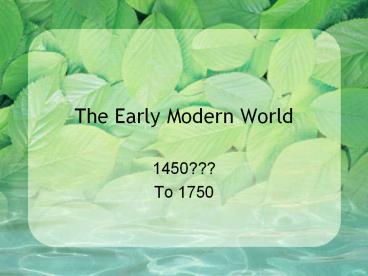The Early Modern World PowerPoint PPT Presentation
1 / 33
Title: The Early Modern World
1
The Early Modern World
- 1450???
- To 1750
2
Problems with periodization
- The beginning of the Modern Era
- 1300?
- 1350?
- 1400?
- 1450?
- 1492?
- WHY?
3
The world around 1300
- Population Decline and growth
- Black Plague (_at_1348)
- Feudalism in Japan (Kamakura) and Europe
- Pax Mongolica Yuan dynasty in China, Kievan Rus
under Mongol rule - Rise of the Inca and Aztec empires
- Mali at its height
4
Ca. 1300
- Delhi Sultanate in South Asia rise of Islam,
decline of Buddhism, competing power bases. - Founding of Ottoman dynasty (1281)
- Continued decline of Byzantium
- Trade circuits in Mediterranean, Indian Ocean,
South China Sea, Trans-Saharan and across the
Eurasian steppe
5
Think about it
- Predict what trends will change and which will
stay the same. - As the world continues to become more integrated
circa 1450, predict which societies are in the
best position to take advantage of new
technologies and new discoveries.
6
Changes in Trade, Technology and Global
Interactions
- Exploration
- Gold, Glory and God
- Empire Building
- Cartography
- Commodities
7
Cultural and Intellectual Development
- Renaissance
- Scientific Revolution
- Enlightenment
- Patronage of the Arts
8
Changing Beliefs
- Reformation
- Neo-Confucianism
- Missionaries Christianity, Islam, Buddhism
9
Renaissance
- Renaissance- growth of idea of HUMANISM belief
in human potential separate from religion. - Patronage of the arts by the public and the
church - Rediscovery of Perspective by artists such as
Raphael in Marriage of the Virgin 1504 - Renaissance was a REBIRTH OF WHAT?
10
Missionaries Jesuits
11
Commodities
- African slave trade
- Note the primary destinations!
12
Commodities Slavery
13
Commodities Sugar, Silver and Slaves
14
Commodities Coffee
- Coffee beans used first in Yemen and then later
in Europe and the Americas - European using chocolate technology from the
Aztecs 17th Century
15
Empire Building
- How do empires rise and expand?
- What factors at this time will help empires
maintain themselves and expand their borders? - Consider the impact and nature of interaction
with others
16
Empires Russia
- Mongol occupation stalled Russian unification and
development - Increasing absolutist rule and territorial
expansion by 16th Century Ivan the Terrible - Role of Russian Orthodox Church
- Peter the Great accelerated westernization
process
17
Empires Ottoman, 1285-1914
- 1350s Initial Ottoman invasion of Europe
- 1453 Ottoman capture of Constantinople
- 1683 Ottoman siege of Vienna
18
Empires Ming China 1368-1644Manchu Qing
Dynasty 1644 - 1912
19
Empires JapanTokugawa, 1600-1853
- Taika, Nara and Heina periods (645-857) height
of cultural borrowing from China - -Tale of Genji Lady Murasaki
- Emergence of warrior class and increasing civil
wars - Encounter with Portuguese 1543
- Isolation from West rise of Tokugawas
- Tokugawa elite followed development in west
(contrast to Chinas hairy barbarian mentality)
20
Empires Mughal India, 1556-1739
- Empire based on military strength
- Akbar attempt to combine beliefs into new
religion to unite Hindu and Muslim subjects
Din-I-Ilahi - Indian textile trade value to Europeans
- Patronage to the arts--Shah Jahan
21
Empires England
- Limited Monarchy and the emergence of
Constitutional Monarchy (1215 Magna Carta is the
beginning) - Civil Wars
- Commonwealth
- Charles II James II
- the Glorious Revolution Bill of Rights
- Enlightenment Ideas
- Colonies in Americas
22
Empires France
- Absolute Monarchy
- King Louis XIV
- I am the State
- Versailles
- Mercantilism
- Territorial expansion in Europe and fur-trading
colonies in Saint Domingue (Haiti) and New France
(Quebec)
23
Empires Dutch
- Dutch East India Company universal carriers
In 1660, employed 12,000 people and had 257
ships. Sought monopolies and large profits. - North America (fur trade along the Hudson river,
New Amsterdam) - Caribbean islands for plantation settlements
- Capetown, South Africa way station
- Southeast Asia spice trade (nutmeg in Banda
islands, cloves in Melaka and pepper in Banten)
24
Empires Spain
- Reconquista ended with the fall of Granada
- Inquisition
- Columbus voyage
- Arrival of Cortez in Mexico and Pizarro in Peru
- Took over existing tributary empires labor
(mita), silver, gold, and foodstuffs - Demographic impact disease, death, and mestizos
25
Spain
26
Empires Portugal
- Search for Maritime route to Asia
- Advanced naval technology caravels, carracks,
astrolabe and compass - Established fortresses along the Gold Coast
sugar plantations and African slave labor - Indian Ocean trade and Da Gama Malindi, Sofala
and Kilwa, Calicut and Goa, and later Macao - Atlantic trade with conquest of Brazil sugar
plantation
27
Brazil, plantation colony
- Portuguese due to Treaty of Tordesillas 1494
- African slave labor used to support the
plantation complex (sugar) - Largest producer of sugar in world first half of
17th C.
28
Empires African
- Characteristics of
- Stateless societies - organized around kinship,
often larger than states, forms of government - Large centralized states increased unity came
from linguistic base Bantu, Christianity and
Islam, as well as indigenous beliefs - Trade markets, international commerce, taxed
trade of unprocessed goods.
OYO--BENIN--KONGO--ASANTE
29
Cartographic Changes
30
Gender and Empire
- Changing roles
- Reigning queens
- Domestic work
31
Demographic and Environmental Changes
- Predict what the consequences of increased
integration and empire building be on population?
On the environment? Think long and short term.
32
Comparisons
- Be able to compare the following
- Imperial systems European monarchy vs. a
land-based Asian empire sea-based empire vs.
land-based - Coercive labor systems
- Empire building in Asia, Africa, Latin America,
and Europe - Russias interaction with the west compared to
others
33
Conclusions
- What are the major themes that seem apparent?
- What global processes are in action?
- Suggest the best possible ways to learn case
studies of these global forces.

